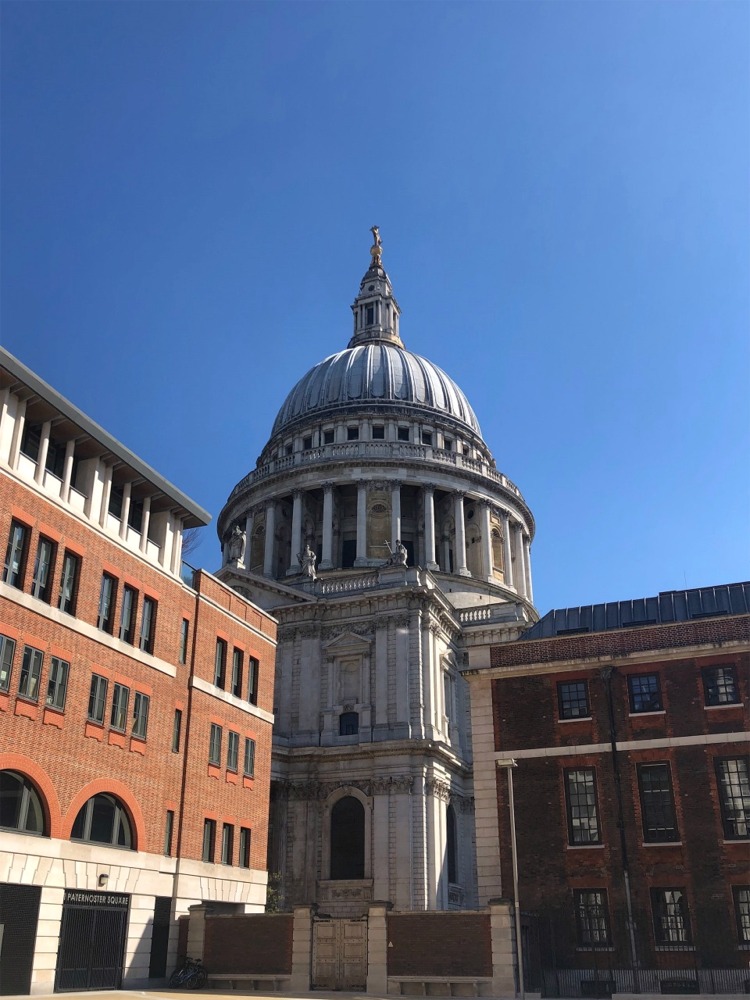St Paul's Cathedral
Home > Photos from England > St. Pauls Cathedral > St Paul's Cathedral's Southern Facade

Through a gap between two buildings, this photograph shows the north facade of St Paul's Cathedral in London, England from Paternoster Square. The building on the right is the Chapter House of St Paul's Cathedral.
Chapter house
A chapter house or chapterhouse is a building or room that is part of a cathedral, monastery, or collegiate church in which meetings are held. When attached to a cathedral, the cathedral chapter meets there. In monasteries, the whole community often met there daily for readings and to hear the abbot or senior monks talk. When attached to a collegiate church, the dean, prebendaries, and canons of the college meet there. The rooms may also be used for other meetings of various sorts; in medieval times monarchs on tour in their territory would often take them over for their meetings and audiences. Synods, ecclesiastical courts, and similar meetings often took place in chapter houses.
Paternoster Square
Paternoster Square is an urban development, owned by the Mitsubishi Estate, next to St Paul's Cathedral in the City of London. The area, which takes its name from Paternoster Row, once centre of the London publishing trade, was devastated by aerial bombardment in The Blitz during World War II. It is now the location of the London Stock Exchange which relocated there from Threadneedle Street in 2004. It is also the location of investment banks such as Goldman Sachs, Merrill, and Nomura Securities, and of fund manager Fidelity Investments. The square itself, i.e. the plaza, is a privately owned public space. In 2004, Christopher Wren's 1669 Temple Bar Gate was re-erected here as an entranceway to the plaza.
The Square is near the top of a modest rise known as Ludgate Hill, the highest part of the City of London. It is characterised by its pedestrianisation and colonnades.
St Paul's Cathedral
St Paul's Cathedral is an Anglican cathedral in London and is the seat of the Bishop of London. The cathedral serves as the mother church of the Diocese of London. It is on Ludgate Hill at the highest point of the City of London and is a Grade I listed building. Its dedication to Paul the Apostle dates back to the original church on this site, founded in AD 604. The present structure, dating from the late 17th century, was designed in the English Baroque style by Sir Christopher Wren. Its construction, completed in Wren's lifetime, was part of a major rebuilding programme in the city after the Great Fire of London. The earlier Gothic cathedral (Old St Paul's Cathedral), largely destroyed in the Great Fire, was a central focus for medieval and early modern London, including Paul's walk and St Paul's Churchyard, being the site of St. Paul's Cross.
The cathedral is one of the most famous and recognisable sights in London. Its dome, surrounded by the spires of Wren's City churches, has dominated the skyline for over 300 years. At 365 ft (111 m) high, it was the tallest building in London from 1710 to 1963. The dome is still one of the highest in the world. St Paul's is the second-largest church building in area in the United Kingdom, after Liverpool Cathedral.
Services held at St Paul's have included the funerals of Admiral Lord Nelson, the Duke of Wellington, Winston Churchill, and Margaret Thatcher; jubilee celebrations for Queen Victoria; an inauguration service for the Metropolitan Hospital Sunday Fund; peace services marking the end of the First and Second World Wars; the wedding of Prince Charles and Lady Diana Spencer; the launch of the Festival of Britain; and the thanksgiving services for the Silver, Golden, Diamond, and Platinum Jubilees and the 80th and 90th birthdays of Queen Elizabeth II. St Paul's Cathedral is the central subject of much promotional material and images of the dome surrounded by the smoke and fire of the Blitz. The cathedral is a working church with hourly prayer and daily services. The tourist entry fee at the door is £21 for adults (Summer 2022, cheaper if booked online), but no charges are made to worshippers attending advertised services.
The nearest underground station is St Paul's, which is 130 yards (120 m) away from St Paul's Cathedral.
From Wikipedia, the free encyclopedia.


